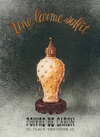At the end of the year, I was going through my papers and I found a few notes I wrote about Indian classical art and the theory of rasa. According to the Natya Sastra, a text about arts dating to between 200 BCE and 200 CE, the purpose of art is to transport the person who experiences it to another universe. Delight, entertainment, even distraction from the routine are reasonable goals too, but the main one is a chance to transcend the ordinary and feel wonder.

The theory of rasa is more complex and fascinating than my short description, but its essence is very easy to grasp. Think of a work of art that has touched you so deeply you forgot about all else. A painting, a film, a sculpture, a perfume. I still think that some of my most vivid experiences of this nature have been connected with scents, and I wrote about one of them previously when I described discovering Guerlain Après L’Ondée as a teenager.
Another element of the Natya Sastra I find intriguing is the way it depicts heroines in art. Such heroines, nayika, are classified in terms of states and their relationships to the heroes of the stories. The work mentions 8 classical states such as a heroine distressed by separation, enraged by her lover or dressing up for an occasion. My favorite one is the so-named Abhisarika Nayika, the heroine who casts aside conventions and dares to go to her lover.

The classical paintings of Abhisarika Nayika depict the heroine walking through a dark forest full of snakes or other monstrous creatures. Sometimes the thunder breaks over her head. Sometimes she’s drenched in rain. Yet, she walks resolutely and without fear, driven by her passion and conviction.

She lifts her skirt gingerly to step over a puddle. She barely glances at the golden anklet she has lost in the grass. She doesn’t hide her face. Why should she ? What greater force than love exists out there? The art, as the Natya Sastra suggests, can be its perfect conduit.
For those who would like to read more on the topic of Indian aesthetics, I highly recommend A Rasa Reader: Classical Indian Aesthetics by Sheldon Pollock. Another book I’ve read and re-read is The Spirit of Indian Painting by BN Goswamy. Finally, Rajput Painting: Romantic, Divine and Courtly Art from India Hardcover by Roda Ahluwalia will tell you more about the nayikas, including the beautiful painting I’ve included in this article (#2).
Painting 1 — the atelier of Nainsukh, 2 — Mola Ram, 3 — from Bilaspur, ca. 1840. Via wiki-images, some rights reserved.













24 Comments
Debi Sen Gupta: Meera and Radha would fit the description of AN. January 7, 2019 at 9:12am
Victoria: I also agree! January 7, 2019 at 10:03am
Debi Sen Gupta: There some beautiful songs which talk about the feelings of Radha. One she is telling her friends that she doesn’t need to wear kajal/kohl as the brilliance of krishnas black skin has made such adornments redundant. January 7, 2019 at 9:18am
Victoria: Love poetry in Sanskrit makes my heart skip a beat. Such sensual, moving images. January 7, 2019 at 10:05am
Klaas Backx: Gorgeous pictures! I love the lightning and the way the trees embrace eachother…..such tenderness….. January 7, 2019 at 10:35am
Victoria: You noticed the same detail I loved about these three images. And the combination of colors is just stunning. January 7, 2019 at 2:10pm
Allison: I like her pose, looking over her shoulder. January 8, 2019 at 2:40am
Victoria: So graceful. January 10, 2019 at 4:14am
Sandra: Beautiful!
One of the members of my husband’s family does a type of Indian dancing, I name of it escapes me, I will have to ask and report back.
Thank you for the book recommendations. Any favorites that you read in 2018?
Happy New Year to you and yours.. January 7, 2019 at 2:13pm
Victoria: Odissi or Bharatanatyam, perhaps? Those are among the most common forms of traditional Indian dance.
I’ll have to think a little bit about your question, but off the top of my head, it was a novel by an Iranian author Zoya Pirzad called I Turn off the Lights. It’s about an Iranian-Armenian woman and the events in her life. The only thing I’m not sure about is whether it was translated into English. It should be, because it’s such an excellent novel. Pirzad really makes you enter the life and mindset of this woman and feel like you’re participating in her day-to-day activities. January 10, 2019 at 4:13am
Sandra: I tried to look for it at the library and online here in the US but nothing came up. Maybe it hasn’t been translated.
Anything else you recommend? January 10, 2019 at 1:42pm
Victoria: I suppose, it wasn’t, which is a shame given that it was one of the most popular novels in Iran since it was published in 2001. But it’s not surprising, given how little gets translated into English.
I read a lot of Joseph Roth and I recommend his short stories, especially “The Stationmaster Fellmayer” and “The Bust of the Emperor.” January 11, 2019 at 6:01am
Allison: Gorgeous! Whenever I visit your blog, I come away inspired. I just ordered The Spirit of Indian Painting book. January 8, 2019 at 2:39am
Victoria: I’m so happy to hear this! January 10, 2019 at 4:14am
Anne: This art is new to me, but I love the colors and themes. The heroine looks fragile, but still so brave and daring. Thank you for a chance to learn something new. January 8, 2019 at 5:11am
Victoria: Very glad to share! January 10, 2019 at 4:14am
eudora: so beautiful and inspiring post.
thanks for sharing and I wish you all a happy new year. January 8, 2019 at 2:42pm
Victoria: Happy New Year to you too! January 10, 2019 at 4:16am
Carine: Enchanting is the word. Love this whole post and paintings. January 9, 2019 at 12:37am
Victoria: Thank you, Carine. January 10, 2019 at 4:17am
Alicia: Art’s goal:”a chance to transcend the ordinary and feel wonder.” Indeed! Longinos (in On the Sublime) agrees from on high.I believe that the first time that I felt it was when at thirteen I visited Chartres. Many times in literature, of course, but at the moment I recall vividly two occasions: Dante Divina Comedia, Inferno v, and the Great Inquisitor in the Brothers Karamazov. The Pantocrator at the Cathedral of Monreale in Sicily, and a small yellow flower breaking the snow by the stream behind my house. January 10, 2019 at 12:37am
Victoria: Beautiful vignettes, Alicia! Thank you for sharing them. January 10, 2019 at 4:19am
Aurora: These miniatures are enchanting, I love each of them, so atmospheric. In the first one the serpents look rather friendly as if they are charmed by the heroine. I know very little about Indian theory of art so was really interested in your post. January 12, 2019 at 6:52am
Victoria: They do, don’t they! 🙂 January 14, 2019 at 4:39am